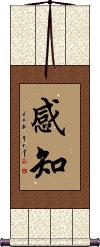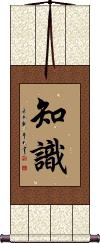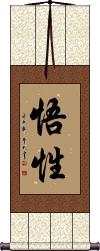Many custom options...
And formats...

Perception in Chinese / Japanese...
Buy a Perception calligraphy wall scroll here!
Personalize your custom “Perception” project by clicking the button next to your favorite “Perception” title below...
Perception
感知 is the Chinese, Japanese Kanji, and old Korean Hanja for perception, awareness, or the act of sensing and noticing.
Perception of Knowledge
知識 has the very strong meaning of “knowledge” and, in some contexts, “learning.”
The first character represents “to know” or “to realize.”
The second character alone refers to the ability to “recognize” or “realize” and can also be used to mean “knowing.”
See Also: Wisdom | Learn From Wisdom
Power of Understanding and Wisdom
悟性 means the power of understanding and insight in Chinese.
It is often associated with Neo-Confucianism. In that regard, it means to realize, perceive, or have the perception of man's true nature. It can also mean finding your soul, the soul of others, or the soul of the world. Some will translate this simply as the state of being “savvy.”
In Japanese, this is often translated as wisdom and understanding.
Not the results for Perception that you were looking for?
Below are some entries from our dictionary that may match your Perception search...
| Characters If shown, 2nd row is Simp. Chinese |
Pronunciation Romanization |
Simple Dictionary Definition |
意 see styles |
yì yi4 i kokoro こころ |
More info & calligraphy: Idea / Thought / Meaning(1) feelings; thoughts; (2) meaning; (personal name) Kokoro Manas, the sixth of the ṣaḍāyatanas or six means of perception, i.e. sight, hearing, smell, taste, touch, and mind. Manas means "mind (in its widest sense as applied to all the mental powers), intellect, intelligence, understanding, perception, sense, conscience, will". M.W. It is "the intellectual function of consciousness", Keith. In Chinese it connotes thought, idea, intention, meaning, will; but in Buddhist terminology its distinctive meaning is mind, or the faculty of thought. |
知 see styles |
zhī zhi1 chih tomoko ともこ |
More info & calligraphy: Realization and Knowledge(1) wisdom; (2) (Buddhist term) jnana (higher knowledge); (female given name) Tomoko To know. Sanskrit root vid, hence vidyā, knowledge; the Vedas, etc. 知 vijñā is to know, 智 is vijñāna, wisdom arising from perception or knowing. |
悟性 see styles |
wù xìng wu4 xing4 wu hsing gosei / gose ごせい |
More info & calligraphy: Power of Understanding and Wisdomwisdom; understanding |
感知 see styles |
gǎn zhī gan3 zhi1 kan chih kanchi かんち |
More info & calligraphy: Perception(noun, transitive verb) perception; sensing; noticing |
眞覺 眞觉 see styles |
zhēn jué zhen1 jue2 chen chüeh shinkaku |
More info & calligraphy: The True and Complete Enlightenment |
知識 知识 see styles |
zhī shi zhi1 shi5 chih shih tomoshiki ともしき |
More info & calligraphy: Perception of Knowledgeknowledge; information; (surname) Tomoshiki (1) To know and perceive, perception, knowledge. (2) A friend, an intimate. (3) The false ideas produced in the mind by common, or unenlightened knowledge; one of the 五識 in 起信論. |
身心 see styles |
shēn xīn shen1 xin1 shen hsin shinshin しんじん |
More info & calligraphy: Body and Mind(noun - becomes adjective with の) mind and body Body and mind, the direct fruit of the previous life. The body is rūpa, the first skandha; mind embraces the other four, consciousness, perception, action, and knowledge; v. 五蘊. |
超能力 see styles |
chāo néng lì chao1 neng2 li4 ch`ao neng li chao neng li chounouryoku / chonoryoku ちょうのうりょく |
More info & calligraphy: Supernatural Energy(1) extra-sensory perception; ESP; psi; psychic ability; (2) psychokinesis; PK |
勘 see styles |
kān kan1 k`an kan satoru さとる |
to investigate; to survey; to collate perception; intuition; the sixth sense; (given name) Satoru To investigate, examine, collate. |
受 see styles |
shòu shou4 shou uke うけ |
to receive; to accept; to suffer; subjected to; to bear; to stand; pleasant; (passive marker); (LGBT) bottom {Buddh} (See 五蘊,十二因縁) vedana (sensation); (place-name) Uke To receive, be, bear; intp. of vedana, 'perception,' 'knowledge obtained by the senses, feeling, sensation.' M. W. It is defined as mental reaction to the object, but in general it means receptivity, or sensation; the two forms of sensation of physical and mental objects are indicated. It is one of the five skandhas; as one of the twelve nidānas it indicates the incipient stage of sensation in the embryo. |
大 see styles |
dài dai4 tai yutaka ゆたか |
see 大夫[dai4 fu5] (pref,adj-na,n) (1) large; big; great; huge; vast; major; important; serious; severe; (prefix) (2) great; prominent; eminent; distinguished; (suffix) (3) -sized; as big as; the size of; (suffix noun) (4) (abbreviation) (See 大学・1) university; (5) large (e.g. serving size); large option; (6) (abbreviation) (See 大の月) long month (i.e. having 31 days); (given name) Yutaka Maha. 摩訶; 麼賀. Great, large, big; all pervading, all-embracing; numerous 多; surpassing ; mysterious 妙; beyond comprehension 不可思議; omnipresent 體無不在. The elements, or essential things, i.e. (a) 三大 The three all-pervasive qualities of the 眞如 q.v. : its 體, 相 , 用 substance, form, and functions, v. 起信論 . (b) 四大 The four tanmātra or elements, earth, water, fire, air (or wind) of the 倶舍論. (c)五大 The five, i.e. the last four and space 空, v. 大日經. (d) 六大 The six elements, earth, water, fire, wind, space (or ether), mind 識. Hīnayāna, emphasizing impersonality 人空, considers these six as the elements of all sentient beings; Mahāyāna, emphasizing the unreality of all things 法空, counts them as elements, but fluid in a flowing stream of life, with mind 識 dominant; the esoteric sect emphasizing nonproduction, or non-creation, regards them as universal and as the Absolute in differentiation. (e) 七大 The 楞嚴經 adds 見 perception, to the six above named to cover the perceptions of the six organs 根. |
想 see styles |
xiǎng xiang3 hsiang nozomu のぞむ |
to think (about); to think of; to devise; to think (that); to believe (that); to desire; to want (to); to miss (feel wistful about the absence of) (1) conception; idea; thought; (2) {Buddh} (See 五蘊) samjna (perception); (given name) Nozomu To think, meditate, reflect, expect; a function of mind. |
識 识 see styles |
zhì zhi4 chih tsuguhide つぐひで |
to record; to write a footnote (1) acquaintanceship; (2) {Buddh} vijnana; consciousness; (3) (after a signature) written by...; (personal name) Tsuguhide vijñāna, "the art of distinguishing, or perceiving, or recognizing, discerning, understanding, comprehending, distinction, intelligence, knowledge, science, learning . . . wisdom." M.W. parijñāna, "perception, thorough knowledge," etc. M.W. It is intp. by 心 the mind, mental discernment, perception, in contrast with the object discerned; also by 了別 understanding and discrimination. There are classifications of 一識 that all things are the one mind, or are metaphysical; 二識 q. v. discriminating the ālaya-vijñāna or primal undivided condition from the mano-vijñāna or that of discrimination; 三識 in the Laṅkāvatāra Sutra, fundamental, manifested and discriminate; 五識 q.v. in the 起信論, i.e. 業, 轉, 現, 知, and 相續識; 六識 the perceptions and discernings of the six organs of sense; also of 8, 9, 10, and 11 識. The most important is the eight of the 起信論, i.e. the perceptions of the six organs of sense, eye, ear, nose, tongue, body (or touch), and mind, together with manas, intp. as 意識 the consciousness of the previous moment, on which the other six depend; the eighth is the ālaya-vijñāna, v. 阿賴耶, in which is contained the seed or stock of all phenomena and which 無沒 loses none, or nothing, is indestructible; a substitute for the seventh is ādāna 'receiving' of the 唯識, which is intp. as 無解 undiscriminated, or indefinite perception; there is a difference of view between the 相 and the 性 schools in regard to the seventh and eight 識; and the latter school add a ninth called the amala, or pure vijñāna, i.e. the non-phenomenal 眞如識. The esoterics add that all phenomena are mental and all things are the one mind, hence the one mind is 無量識 unlimited mind or knowledge, every kind of knowledge, or omniscience. vijñāna is one of the twelve nidānas.; Ālaya-vijñāna and mano-vijñāna; i. e. 阿梨耶 | and 分別事 |; v. 識. |
一識 一识 see styles |
yī shì yi1 shi4 i shih isshiki |
One sense or perception; the one individual intelligence or soul which uses the various senses, likened to a monkey which climbs in and out of the various windows of a house— a Satyasiddhi and Sautrāntika doctrine. Also, a Vairocana maṇḍala. |
七大 see styles |
qī dà qi1 da4 ch`i ta chi ta shichidai |
Earth , water, fire, wind, space (or ether), sight, and perception 地, 水, 火, 風, 空, 見, 証識; cf. 大, 五大and 六境; 見大 and 六根; 識大 and 六識. |
三惑 see styles |
sān huò san1 huo4 san huo sanwaku; sannaku さんわく; さんなく |
{Buddh} three mental disturbances A Tiantai classification of the three delusions, also styled 三煩惱; 三漏; 三垢; 三結; trials or temptations, leakages, uncleannesses, and bonds. The first of the following three is common to all disciples, the two last to bodhisattvas. They arise from (a) 見, 思, 惑 things seen and thought, i.e. illusions from imperfect perception, with temptation to love, hate, etc.; to be rid of these false views and temptations is the discipline and nirvāṇa of ascetic or Hīnayāna Buddhists. Mahāyāna proceeds further in and by its bodhisattva aims, which produce their own difficulties, i.e. (b) 塵沙惑 illusion and temptation through the immense variety of duties in saving men; and (c) 無明惑 illusions and temptations that arise from failure philosophically to understand things in their reality. |
九地 see styles |
jiǔ dì jiu3 di4 chiu ti kuji くじ |
very low land; (surname) Kuji The nine lands, i.e. the 欲界 realm of desire or sensuous realm the four 色界 realms of form or material forms; and the four 無色界 formless realms, or realms beyond form; v. 九有, 九有情居, 禪 and 定. The nine realms are:—(1) 欲界五趣地; the desire realm with its five gati, i.e. hells, hungry ghosts, animals, men, and devas. In the four form-realms are:— (2) 離生喜樂地 Paradise after earthly life, this is also the first dhyāna, or subject of meditation, 初禪. (3) 定生喜樂地 Paradise of cessation of rebirth, 二禪. (4) 離喜妙樂地 Land of wondrous joy after the previous joys, 三禪. (5) 捨念淸淨地 The Pure Land of abandonment of thought, or recollection (of past delights), 四禪. The four formless, or infinite realms, catur arūpa dhātu, are:—(6) 空無邊處地 ākāśānantyā-yatanam, the land of infinite space; also the first samādhi, 第一定. (7) 識無邊處地 vijñānānamtyāyatanam, the land of omniscience, or infinite perception, 二定. (8) 無所有處地 ākiñcanyāyatana, the land of nothingness, 三定. (9) 非想非非想處地 naivasaṁjñānā-saṁjñāyatana, the land (of knowledge) without thinking or not thinking, or where there is neither consciousness nor unconsciousness, i.e. above either; this is the 四定. Eitel says that in the last four, "Life lasts 20,000 great kalpas in the 1st, 40,000 in the 2nd, 60,000 in the 3rd, and 80,000 great kalpas in the 4th of these heavens." |
九識 九识 see styles |
jiǔ shì jiu3 shi4 chiu shih kumi くみ |
(female given name) Kumi The kinds of cognition or consciousness (vijñāna); those of sight, hearing, smell, taste, touch, mind, mānas (or阿陁那識 ādāna), i.e. mental perception; 阿賴耶 ālāya, bodhi-consciousness, and 阿摩羅識 amala, purified or Buddha-consciousness. There is considerable difference as to the meaning of the last three. |
五心 see styles |
wǔ xīn wu3 xin1 wu hsin go shin |
The five conditions of mind produced by objective perception: 卒爾心 immediate or instantaneous, the first impression; 尋求心attention, or inquiry; 決定心conclusion, decision; 染淨心the effect, evil or good; 等流心the production therefrom of other causations. |
五果 see styles |
wǔ guǒ wu3 guo3 wu kuo goka ごか |
(1) five fruits (peach, Japanese plum, apricot, jujube, Japanese chestnut); (2) (Buddhist term) five types of effect in cause-and-effect relationships; (3) (Buddhist term) five effects of ignorance and formations on one's current life The five fruits, or effects; there are various groups, e. g. I. (1) 異熟果 fruit ripening divergently, e. g. pleasure and goodness are in different categories; present organs accord in pain or pleasure with their past good or evil deeds; (2) 等流果 fruit of the same order, e. g. goodness reborn from previous goodness; (3) 土用果 present position and function fruit, the rewards of moral merit in previous lives; (4) 增上果 superior fruit, or position arising from previous earnest endeavor and superior capacity: (5) 離繋果 fruit of freedom from all bonds, nirvana fruit. II. Fruit, or rebirth: (1) 識 conception (viewed psychologically); (2) 名色 formation mental and physical; (3) 六處 the six organs of perception complete; (4) 觸 their birth and contact with the world; (5) 受 consciousness. III. Five orders of fruit, with stones, pips, shells (as nuts), chaff-like (as pine seeds), and with pods. |
五界 see styles |
wǔ jiè wu3 jie4 wu chieh gokai ごかい |
(place-name) Gokai five factors [of sensory perception] |
五蘊 五蕴 see styles |
wǔ yùn wu3 yun4 wu yün goun / gon ごうん |
the Five Aggregates (from Sanskrit "skandha") (Buddhism) {Buddh} the five skandhas (matter, sensation, perception, mental formations and consciousness); the five aggregates The five skandhas, pañca-skandha: also 五陰; 五衆; 五塞犍陀 The five cumulations, substances, or aggregates, i. e. the components of an intelligent being, specially a human being: (1) 色 rūpa, form, matter, the physical form related to the five organs of sense; (2) 受 vedana, reception, sensation, feeling, the functioning of the mind or senses in connection with affairs and things; (3) 想 saṃjñā, conception, or discerning; the functioning of mind in distinguishing; (4) 行 saṃskāra, the functioning of mind in its processes regarding like and dislike, good and evil, etc.; (5) 識 vijñāna, mental faculty in regard to perception and cognition, discriminative of affairs and things. The first is said to be physical, the other four mental qualities; (2), (3), and (4) are associated with mental functioning, and therefore with 心所; (5) is associated with the faculty or nature of the mind 心王 manas. Eitel gives— form, perception, consciousness, action, knowledge. See also Keith's Buddhist Philosophy, 85-91. |
五陰 五阴 see styles |
wǔ yīn wu3 yin1 wu yin goon ごおん |
(archaism) {Buddh} (See 五蘊) the five skandhas (matter, sensation, perception, mental formations and consciousness); the five aggregates 五衆 see 五蘊. 陰 is the older term. |
会得 see styles |
etoku えとく |
(noun, transitive verb) understanding; comprehension; grasp; perception; appreciation; mastery (of an art or skill) |
似量 see styles |
sì liáng si4 liang2 ssu liang jiryō |
mistaken perception or cognition |
倒想 see styles |
dào xiǎng dao4 xiang3 tao hsiang tōsō |
distorted perception |
內緣 内缘 see styles |
nèi yuán nei4 yuan2 nei yüan naien |
The condition of perception arising from the five senses; also immediate, conditional, or environmental causes, in contrast with the more remote. |
內識 内识 see styles |
nèi shì nei4 shi4 nei shih naishiki |
Internal perception, idem 心識. |
八識 八识 see styles |
bā shì ba1 shi4 pa shih hasshiki; hachishiki はっしき; はちしき |
{Buddh} eight consciousnesses (one for each of the five senses, consciousness of the mind, self-consciousness and store consciousness) The eight parijñāna, or kinds of cognition, perception, or consciousness. They are the five senses of cakṣur-vijñāna, śrotra-v., ghrāna-v., jihvā-v., and kāya-v., i.e. seeing, hearing, smelling, tasting, and touch. The sixth is mano-vijñāna, the mental sense, or intellect, v. 末那. It is defined as 意 mentality, apprehension, or by some as will. The seventh is styled kliṣṭa-mano-vijñāna 末那識 discriminated from the last as 思量 pondering, calculating; it is the discriminating and constructive sense, more than the intellectually perceptive; as infected by the ālaya-vijñāna., or receiving "seeds" from it, it is considered as the cause of all egoism and individualizing, i.e. of men and things, therefore of all illusion arising from assuming the seeming as the real. The eighth is the ālaya-vijñāna, 阿頼耶識 which is the storehouse, or basis from which come all "seeds"of consciousness. The seventh is also defined as the ādāna 阿陀那識 or "laying hold of" or "holding on to" consciousness. |
六入 see styles |
liù rù liu4 ru4 liu ju rokunyuu / rokunyu ろくにゅう |
{Buddh} six sense organs (eyes, ears, nose, tongue, body, and mind) ṣaḍāyatana; 六阿耶怛那 (or 六阿也怛那) the six entrances, or locations, both the organ and the sensation — eye, ear, nose, tongue, body, and mind; sight, hearing, smell, taste, touch, and perception. The six form one of the twelve nidanas, see 十二因緣. The 六根 are the six organs, the 六境 the six objects, and the 六塵 or guṇas, the six inherent qualities. The later term is 六處 q. v.; The "six entries" ṣaḍāyatana, which form one of the links in the chain of causaton, v. 十二因緣 the preceding link being觸contact, and the succeeding link 識 perception. The six are the qualities and effects of the six organs of sense producing sight, hearing, smell, taste, touch, and thought (or mental presentations). v. also 二入. |
Click here for more Perception results from our dictionary
The following table may be helpful for those studying Chinese or Japanese...
| Title | Characters | Romaji (Romanized Japanese) | Various forms of Romanized Chinese | |
| Perception | 感知 | kan chi / kanchi | gǎn zhī / gan3 zhi1 / gan zhi / ganzhi | kan chih / kanchih |
| Perception of Knowledge | 知識 知识 | chishiki | zhī shi / zhi1 shi / zhi shi / zhishi | chih shih / chihshih |
| Power of Understanding and Wisdom | 悟性 | gosei | wù xìng / wu4 xing4 / wu xing / wuxing | wu hsing / wuhsing |
| In some entries above you will see that characters have different versions above and below a line. In these cases, the characters above the line are Traditional Chinese, while the ones below are Simplified Chinese. | ||||
Successful Chinese Character and Japanese Kanji calligraphy searches within the last few hours...






